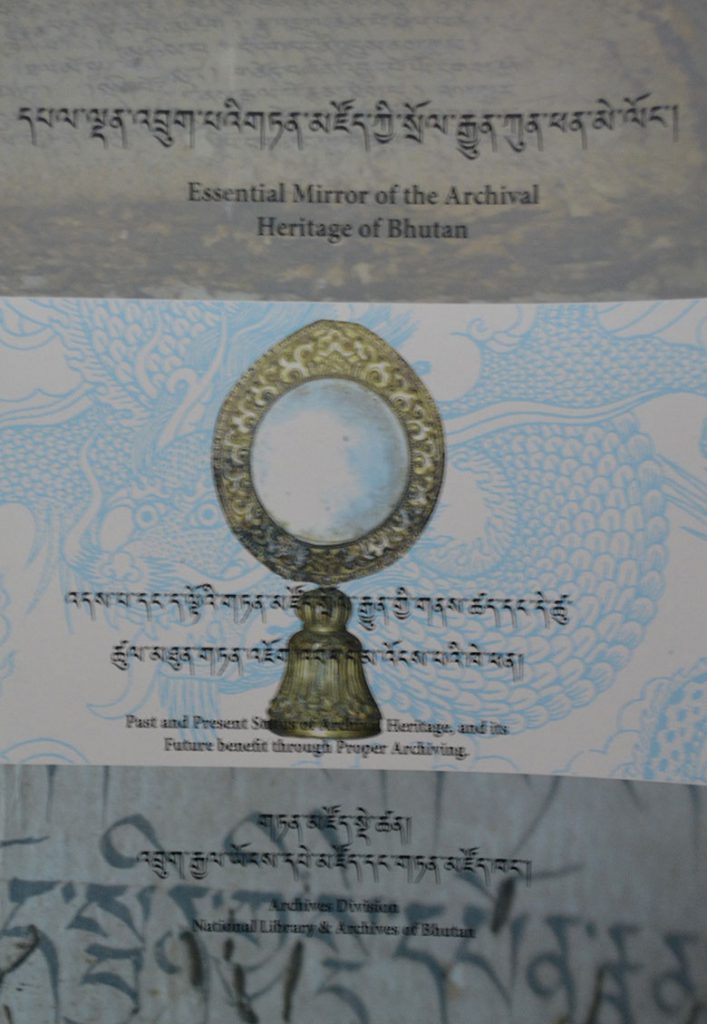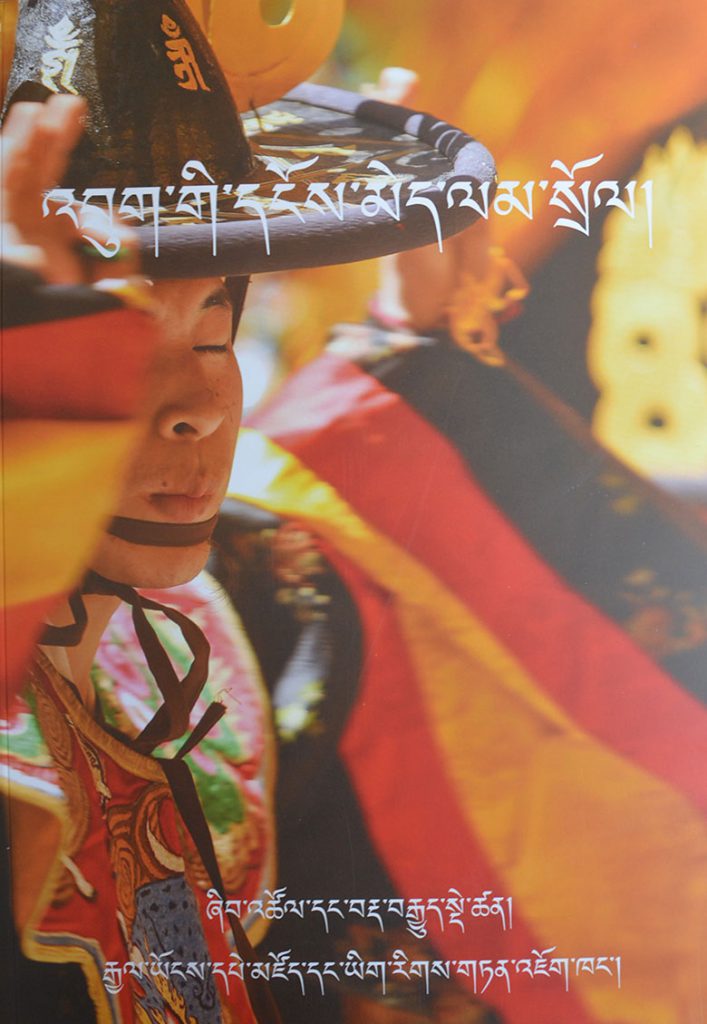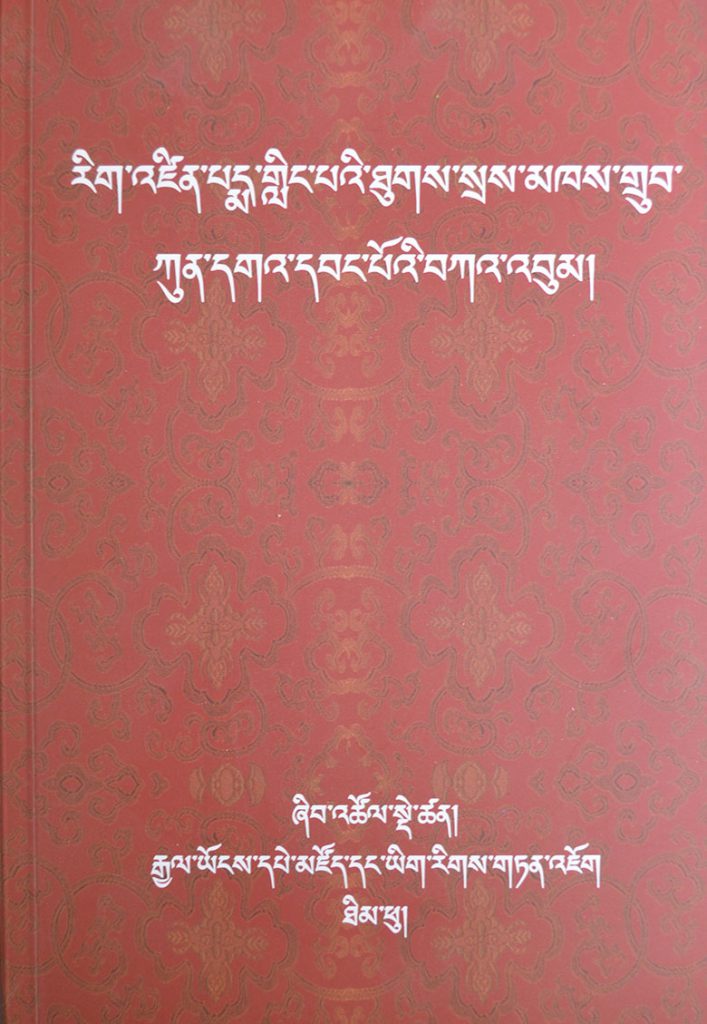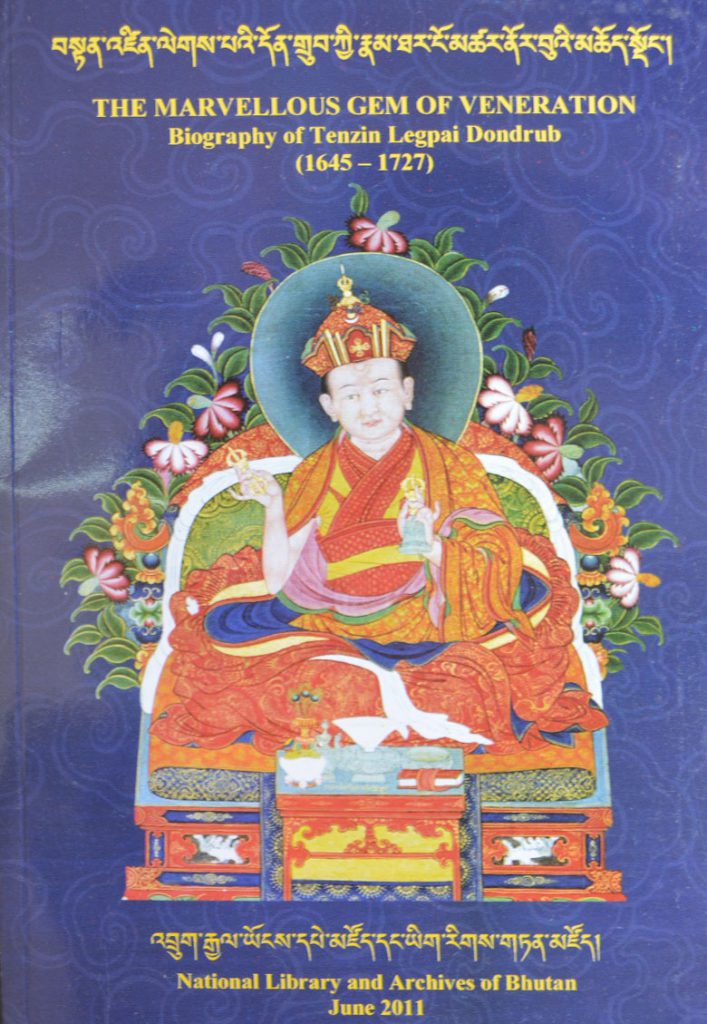
Written Scripts and Calligraphies of Bhutan: Origins and Evolution in the Buddhist Himalaya, 2020

Druk gyi Drichun and Partrun Lamsol (in Dzongkha), 2020

Writing and Print Culture of Bhutan, 2021 (English Translation of Druk gyi Drichun and Partrun Lamsol)

རྒྱལ་ཡོངས་ཡིག་ཆས་གཏན་མཛོད་ཐོ་བཀོད་བརྟག་ཞིབ་གནད་སྡུད། National Archival Survey Data, 2018

Splendours of our Culture: Festivals of Bumthang Dzongkhag, 2018

ཆོས་སྐད་དང་སཾསྐྲིཊ་ཤན་སྦྱར་ཚིག་མཛོད། 2017

ངག་དབང་གྲགས་པའི་རྣམ་ཐར། 2017

སློབ་དཔོན་འཇམ་དཔལ་རྡོ་རྗེའི་གསུང་འབུམ་ཨེ་ཝཾ། 2017

རྫོང་ཁག་དགུ་གི་ལྷ་ཁང་དགོན་སྡེའི་གསུང་རྟེན་ཐོ་བཀོད།༼དེབ་གཉིས་པ།༽2016

ཆོས་རྗེ་འབྲུག་པ་ཀུན་ལེགས་ཀྱི་རྣམ་ཐར། 2016

Bhutan National Bibliography, 2016

དཔལ་ལྡན་འབྲུག་པའི་གཏན་མཛོད་ཀྱི་སྲོལ་རྒྱུན་ཀུན་ཕན་མེ་ལོང་། Essential Mirror of the Archival Heritage of Bhutan. 2015 (Proceedings)

རྒྱལ་གསུང་དམ་པའི་གཏེར་མཛོད། 2015

གཏེར་སྟོན་ཚེ་རིང་རྡོ་རྗེའི་རྣམ་ཐར། དཔེ་གཟུགས་དང་དེབ་གཟུགས། 2015

འབྲུག་གི་དངོས་མེད་ལམ་སྲོལ། 2015

Intangible Cultural Heritage of Bhutan (English) 2015

འབྲུག་རྒྱལ་ཡོངས་དཔེ་མཛོད་ཀྱི་གཏེར་ཆོས་དང་གསུང་འབུམ་གྱི་དཀར་ཆག་མཐོང་བ་རབ་གསལ། (Catalogue of Treasure Teaching and the collected works of Buddhist masters held in the National Library & Archives) 2014

Conserving our Heritage: Evolution of the National Library of Bhutan. 2013
The National Library was established in 1967 as part of a government program to preserve and promote the country’s rich cultural and religious heritage in the face of the modernization process which had begun in 1961. This book gives a full account of the library’s wide-ranging activities and programs over the years of its transformation into the present-day modern National Library & Archives of Bhutan. The author (a professional librarian) has included much explanatory material in the form of footnotes, appendices and a glossary, in order to keep the content accessible and interesting for both the specialist and the general reader.

མེ་སག་ལམ་སྲོལ་གྱི་རྩ་བ་ནྱའི་གྲོ་དྷའི་ས་བོན། From Yak-herding to Enlightenment: The Legend of Thöpa Gali – A Heritage Narrative of the Merak-Sakteng Community, in Choekey, Dzongkha & English. 2013
The Legend of Thöpa Gali is a popular tale in the communities of Merak, Sakteng, and Khaling Dawzor. It serves as a heritage document of the nomads of Merak and Sakteng. In this ethnographic legend, Thöpa Gali describes how he discovered a yak and became a professional nomad. He describes almost all the important aspects and routines of nomadic life right from tying the limbs of a yak for milking to the tethering of a nomadic mastiff guard dog. Having mastered the nomadic life, he finally attains enlightenment.

འབྲུག་ཆོས་སྲིད་ཀྱི་རབས། (Druk gyi Gyalrab) Religious and Political History of Bhutan, in Dzongkha, by Dasho Phuntso Wangdu 2nd ed. (2013)

རིག་འཛིན་པདྨ་གླིང་པའི་ཐུགས་སྲས་མཁས་གྲུབ་ཀུན་དགའ་དབང་པོའི་བཀའ་འབུམ། The collected teachings of Pema Lingpa’s lineage son, Khedrub Kunga Wangpo, in Choekey, edited and with an extensive introduction by Dasho Sangye Dorji. (2012)
Hitherto, little has been known about Kunga Wangpo other than that Bhutan’s first king is descended from the house of Dungkhar Choje, an offshoot of Kunga Wangpo’s own family line, Khouchung Choje. Kunga Wangpo’s collected works cover his teachings and meditative experiences at different periods of his life but do not include any biographical details. This new edition includes a completely new chapter on Kunga Wangpo’s life by Dasho Sangye Dorji, former secretary of the Dzongkha Development Commission. Dasho Sangye kindly assisted the Research Division in editing the text, to which he also added a new chapter (of 108 pages) on Kunga Wangpo’s life based on his own research.

སྒྲོལ་མའི་ལོ་རྒྱུས་མཐོང་ཐོས་ཡིད་འཕྲོག། (Drolmai logyue thong-thoe yid-throg) The Entrancing Legend of Dolma, the Deity of Tara, by Taranatha, translated from Choekey to Dzongkha by Ugyen Tenzin. (2011)
Available for many years in English translation as ‘The golden rosary, origins of the tantra of the Bodhisattva Tara’, a Dzongkha edition of renowned scholar, Taranatha’s 1604 work had been lacking hitherto. The Tantric meditation deity Dolma occupies an important place in the Vajrayana spiritual landscape of Bhutan, and it is hoped that this translation from the classical language into more user-friendly Dzongkha by NLAB deputy chief librarian, Ugyen Tenzin will serve to encourage wider readership amongst Bhutanese.

བསྟན་འཛིན་ལེགས་པའི་དོན་གྲུབ་ཀྱི་རྣམ་ཐར་ངོ་མཚར་ནོར་བུའི་ཆོས་སྡོང་། (Gangteng Trulku Legpai Dondrub kyi namthar) The Marvellous Gem of Veneration: Biography of Tenzin Legpai Dondrub (1645-1727) by Gelong Tenzin Chogyal. Republished with the addition of a comprehensive summary of the Choekey text in both Dzongkha and English by Gengop Karchung. (2011)
This work was republished with the addition of a comprehensive summary of the Choekey text in both English and Dzongkha by NLAB research officer, Gengop Karchung. The biography of the second Gangteng Trulku is a rare and important document which as well as giving an account of the contributions made by Je Tenzin Legpai Dondrub (1654-1727) to the welfare of the country, also illustrates the status of Buddhism in 17th-18th century Bhutan and provides insight into the state of the Peling tradition at the time.

རང་ལུགས་རྫ་བཟོ་རིག་པའི་རྣམ་བཤད། (Ranglug dzazoi rigpai namshad) The Traditional Art of Pottery in Bhutan, in Dzongkha, by Kunzang Dorje. (2011)
In this book, RAPA senior researcher, Kunzang Dorji summarizes the history of pottery making in Bhutan and gives a general account of the pottery making process, equipment and firing techniques.

དྲན་གཏམ་ཟླ་བའི་བདུད་རྩི། མཁས་གྲུབ་ཆེན་པོ་བླ་མ་སྨོན་ལམ་རབ་བཟང་གི་མཛད་རྣམ། (Den Tam Drawai Dutsi) The Biography of Lama Monlam Rabzang, in Dzongkha, by Dorji Gyeltshen. (2010)
Dealing with the life and works of Lama Monlam Rabzang (1878-1945) a learned and renowned Bhutanese Buddhist master who also became an expert sculptor and traditional painter, this publication subsequently won the Dzongkha Development Commission’s award for best book of the year 2010-2011, in competition with the works of 30 other authors.

Life of King Sindha (Chakhar Gyalpo) & The Clear Mirror of Predictions, compiled and edited by Yonten Dargye. (2009)
The manuscript of the biography of King Sindha who was said to have been the founder of a short-lived kingdom in Bumthang, was rediscovered in the 14th century and is one of the most important terma texts to have been revealed in Bhutan to date. Authored by Denma Tsemang, one of the principal disciples of Padmasambhava (Guru Rinpoche) the work highlights important events of the Guru’s visit to Bumthang in the 8th century. The contents of this new, modern edition comprise an annotated English translation of the Choekey text, a facsimile reprint of the original biography and a corrected Dzongkha version in modern print format, so as to facilitate reading of the English translation along with the original text.

ཕྱག་རྗོགས་དབུ་གསུམ་གྱི་མན་ངག་གཅིག་ཏུ་བསྡུས་པབདུད་རྩིའི་སྙིང་པོ་བཞུགས་སོ། 2008

འདས་པའི་དུས་རབས་ཀྱི་མེ་ལོང་དང་མ་འོངས་བའི་འབྲེལ་ཟམ། Written Treasures of Bhutan: Mirror of the Past and Bridge to the Future, edited by John Ardussi. Proceedings of an international conference mounted in Thimphu in 2005. (vol. vol. II English). (2008)

འདས་པའི་དུས་རབས་ཀྱི་མེ་ལོང་དང་མ་འོངས་བའི་འབྲེལ་ཟམ། Written Treasures of Bhutan: Mirror of the Past and Bridge to the Future, edited by John Ardussi. Proceedings of an international conference mounted in Thimphu in 2005. (vol. I Choekey, (2008)

Play of the Omniscient: Life and Works of Jamgon Ngawang Gyaltshen (17th to 18th Century) by Yonten Dargye & P. K. Sørensen with Gyonpo Tshering. (2008)
This work is an annotated translation of the 9th Je Khenpo’s biography of Jamgon Ngawang Gyaltshen. The 9th Je Khenpo, Shakya Rinchen was an outstanding scholar, and his biography of Jamgon Ngawang Gyaltsen (1647–1732) is considered a landmark in the literary and religious history of Bhutan. Jamgon Ngawang Gyaltshen is regarded by Bhutanese as a reincarnation of the Buddha Maitreya, and the 9th Je Khenpo’s account of his life is a major historical source of information concerning political events in Bhutan during the 17th and early 18th centuries. Jamgon Ngawang Gyaltshen’s legacy has proved enduring in numerous fields relating to religious arts, crafts and ritual practices in Bhutan. The authors have rearranged the contents of Shakya Rinchen’s elegantly written narrative to give a better narrative flow for the English translation of the biography.

The Biography of Phajo Drugom Zhigpo: The Current of Compassion, by Yonten Dargye & P.K. Sorensen. (2001)
The revered sage Phajo Drugom Zhigpo (1184–1251), was sent south by his teacher after completing religious studies at Druk Ralung and went on to establish the Drukpa Kagyu lineage in Bhutan, thus fulfilling a prophesy which had been made by the founder of the lineage before he expired. This 13th century ascetic and his numerous descendants played a significant religious and political role in turning Bhutan into a flourishing stronghold for the Drukpa order. The biography of Phajo Drugom Zhipo is one of the most important documents of this early period of dissemination of the Kagyu tradition in Bhutan. The work is presented here for the first time in an English rendition.

འབྲུག་གི་གླུ་མཛོད། A Treasure of Songs of the Kingdom of Bhutan, in Dzongkha, by Gyonpo Tshering. (1999)
This work comprises a selection of traditional, old songs which Gyonpo Tshering has gathered up from across Bhutan.

སྒྲིག་ལམ་རྣམ་གཞག་གི་དེབ་ཐེར་ནོར་བུའི་འཕྲེང་བ། A book on Bhutanese formal etiquette, in Dzongkha, by Dorji Gyaltshen. (1999)

སྒྲིག་ལམ་རྣམ་གཞག་ལག་ལེན་འཐབ་ཐངས། 1999
A Manual in Dzongkha, compiled by Gangkhar Wangdue, with English translation by Yonten Dargye. 320 p., with illustrations. (1999)

གཟུངས་འབུལ་ལག་ལེན་མཐོང་བས་ཤེས་པ། (Handbook for Zung Practitioners), a book on installing dharani (gzung)and relics in sacred objects for consecration, in Dzongkha, by Khenpo Phuntsho Tashi. (1998)
This comprehensive and extensively illustrated work on installing dharani (gzung) and relics in sacred objects for consecration includes a wealth of valuable information on traditional zung-related practices, some now on the verge of dying out. The author took three years to compile his text, the work entailing exhaustive research on a difficult tantric text and its commentaries. Through this publication, much important knowledge on zung, hitherto hidden within difficult scripts, was now made accessible to people.

Prayer of Preliminary Practice: the Guide Towards Enlightenment, by the 9th Je Khenpo, Shakya Rinchen, translated by Yonten Dargye (1997).
This is the first text to be translated into English by the library’s research team. The Choekey text and English translation appear on facing pages. The work is one of the most important liturgical texts of preliminary practices for the Mahamudra tradition of the Drukpa Kagyu School.
Note
The Publications can be purchased from the NLAB Bookshop, situated at the NLAB complex in Kawajangsa, Thimphu. Please note that our publications are only available at the NLAB Bookshop.
